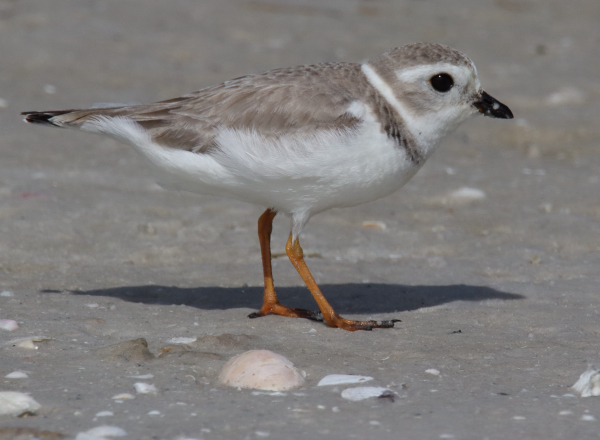
Endangered Piping Plovers rest and feed along South Carolina beaches through the winter before migrating north to nest (photo by Paul Konrad).
|
Endangered Piping Plovers rest and feed along South Carolina beaches through the winter before migrating north to nest. About 1/3 of the American Oystercatcher population winters there too. State-threatened Wilson’s Plovers and Least Terns nest and raise their young on South Carolina beaches too, and the coast is an important migration stopover area for about 40 percent of the Atlantic Coast population of Red Knots. In 2016 Audubon South Carolina launched the Shorebird Stewardship program to help protect these 5 vulnerable species along with other coastal birds by informing people about them and monitoring areas the birds frequent most.
Human disturbance is one of the greatest threats these shorebirds face along the nearly 3,000 miles of South Carolina’s tidal shorelines, whether it’s people walking through resting flocks or unleashed dogs getting too close to nesting birds. “What started as a seasonal program expanded into a year-round need for stewardship,” explained Nolan Schillerstrom, Audubon South Carolina’s coastal program associate. “We realized that it really needed a year-round effort.”
Depending on the year, Audubon South Carolina now sends “Shorebird Stewards” to between 10 and 13 different coastal sites to help prevent human disturbance. The stewards undergo training each year to learn more about coastal birds and their behaviors, while learning about how to converse with beachgoers to help them gain an interest in the birds and to care about them. Plus, the stewards help to post signs alerting people to nesting areas or resting sites.
Audubon South Carolina is already seeing positive results from the program, with improved nesting success of American Oystercatchers, Wilson’s Plovers, and Least Terns at sites they help manage, noted Allyssa Zebrowski, Audubon South Carolina’s coastal stewardship coordinator. That nesting success is partly attributed to the program’s growing number of volunteers and increased notoriety each year.
It’s clear that stewardship plays a vital role in protecting coastal shorebirds across the country. A recent study led by Audubon’s science team found that 4 vulnerable coastal bird species’ populations increased 2 to 34 times faster at stewardship sites compared to the same species that were monitored at protected areas without stewards.
The Shorebird Stewardship program works with a variety of partners to reduce human disturbances by increasing awareness about birds, and their efforts are a good example of what can be done to help species of concern, including threatened or endangered species. In essence, that kind of effort can be replicated wherever needed as birders and other interested people get involved.
For more information about the Shorebird Stewardship program led by Audubon South Carolina, see How Audubon South Carolina Protects Their Coastal Birds and the Places They Need | Audubon